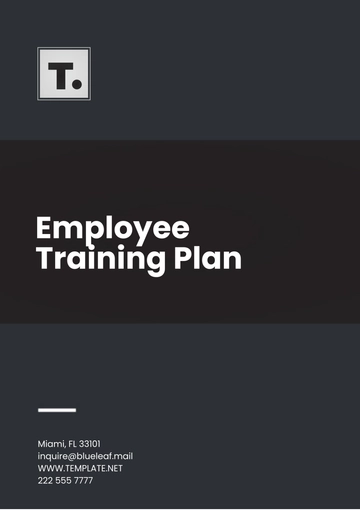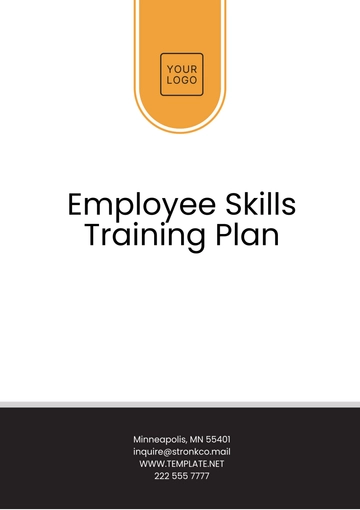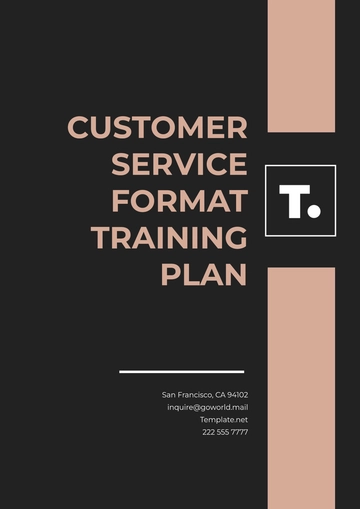Free Virtual Employee Training Plan

I. Introduction
This Virtual Employee Training Plan has been designed to enhance employee performance, skill acquisition, and career growth through a structured and flexible online format. The plan focuses on providing accessible, engaging, and interactive training experiences that employees can participate in from the comfort of their locations, regardless of geographical constraints.
II. Training Objectives
The objectives of this training program are to ensure the workforce is equipped with the essential skills, knowledge, and motivation to excel in their roles and contribute to organizational success.
A. Skill Development
Equip employees with the specific skills and competencies necessary for their current roles and future growth.
Emphasize both technical abilities, such as software tools and systems, and interpersonal skills, like communication and teamwork.
B. Employee Engagement
Increase employee engagement and retention by offering interactive, dynamic, and motivational learning experiences.
Foster a growth mindset by making learning continuous, accessible, and rewarding.
C. Organizational Growth
Align employee training with company goals and objectives.
Improve organizational performance through the upskilling of staff, enabling the company to adapt to emerging trends and technological advancements.
III. Training Methods
The training will incorporate a variety of methods to cater to different learning styles, ensuring that all employees have the opportunity to absorb and apply new information effectively.
A. Online Workshops
Interactive Sessions with Industry Experts: Facilitated live workshops with subject matter experts, providing opportunities for real-time learning and Q&A.
Use of Breakout Rooms for Group Discussions: Encouraging peer-to-peer learning and teamwork in small group settings during live sessions.
B. E-Learning Modules
Self-Paced Video Tutorials: On-demand, recorded training videos that employees can watch at their own pace.
Quizzes and Assessments: Frequent quizzes to assess understanding and reinforce key learnings. Interactive assignments to promote deeper engagement.
C. Virtual Coaching
One-on-One Virtual Mentoring Sessions: Personalized coaching where employees can discuss challenges, set goals, and receive expert advice.
Goal-Setting and Progress Tracking: Coaching sessions focused on helping employees set measurable goals and track progress against performance targets.
IV. Training Schedule
A structured timeline to ensure the training process remains on track and employees are progressively building on their skills.
Week | Activities | Responsible |
|---|---|---|
1 | Introduction to Training Program | HR Team |
2-3 | Online Workshops | Industry Experts |
4-6 | E-Learning Modules | Training Department |
7-8 | Virtual Coaching | Coaching Staff |
9 | Final Evaluation and Feedback | HR Team |
10 | Certification and Program Wrap-Up | HR & Coaching Staff |
V. Evaluation and Feedback
Effective evaluation will be key in assessing the success of the training and identifying areas for future improvement.
A. Participant Feedback
Collect feedback through surveys and interviews after each training phase.
Use responses to adjust content, delivery methods, and program pacing for continuous improvement.
Develop a scoring system, such as a Likert scale, to measure participant satisfaction and perceived value.
B. Performance Metrics
Pre- and Post-Assessment: Measure performance before and after each training segment to determine knowledge gain and skill improvement.
KPIs (Key Performance Indicators): Establish quantifiable objectives (such as boosting productivity, decreasing errors, and improving employee engagement scores) to assess the effectiveness of training.
Behavioral Changes: Monitor if training leads to positive changes in work performance, such as improved efficiency or communication.
C. Certification of Completion
Award certificates to employees who complete the program, providing a tangible incentive and a formal recognition of their effort and achievement.
VI. Technology and Platform Support
The training plan will utilize a robust and reliable Learning Management System (LMS) to host all online modules, track progress, and ensure seamless delivery of training content.
LMS Features:
Easy access to training materials, quizzes, and resources.
Real-time progress tracking and feedback notifications.
Gamification elements to boost motivation and engagement.
Technical Support:
A dedicated helpdesk to assist employees with technical issues during training.
Tutorials and troubleshooting guides are available for common LMS issues.
VII. Trainer and Participant Support
To ensure the success of the training program, support mechanisms will be in place for both trainers and participants.
A. Trainer Support
Provide instructors with training on effective online teaching strategies and engagement tools.
Offer regular check-ins for instructors to discuss challenges and refine their approach.
B. Participant Support
Offer virtual office hours where employees can ask questions and clarify doubts.
Create a peer support network, encouraging employees to collaborate, share knowledge, and learn from each other.
VIII. Conclusion
This Virtual Employee Training Plan aims to create a culture of continuous learning, where employees are empowered to develop new skills, stay motivated, and contribute meaningfully to their roles and the organization. By providing structured, flexible, and engaging training, we ensure that employees are not only equipped for their current jobs but also prepared for future career growth in a virtual working environment.
- 100% Customizable, free editor
- Access 1 Million+ Templates, photo’s & graphics
- Download or share as a template
- Click and replace photos, graphics, text, backgrounds
- Resize, crop, AI write & more
- Access advanced editor
Boost productivity with Template.net's Virtual Employee Training Plan Template! This customizable and editable template is designed to streamline employee onboarding and skill development. Easily tailored to your specific needs, it’s editable in our AI Editor Tool, making it perfect for crafting clear, effective training plans that set your team up for success.
You may also like
- Finance Plan
- Construction Plan
- Sales Plan
- Development Plan
- Career Plan
- Budget Plan
- HR Plan
- Education Plan
- Transition Plan
- Work Plan
- Training Plan
- Communication Plan
- Operation Plan
- Health And Safety Plan
- Strategy Plan
- Professional Development Plan
- Advertising Plan
- Risk Management Plan
- Restaurant Plan
- School Plan
- Nursing Home Patient Care Plan
- Nursing Care Plan
- Plan Event
- Startup Plan
- Social Media Plan
- Staffing Plan
- Annual Plan
- Content Plan
- Payment Plan
- Implementation Plan
- Hotel Plan
- Workout Plan
- Accounting Plan
- Campaign Plan
- Essay Plan
- 30 60 90 Day Plan
- Research Plan
- Recruitment Plan
- 90 Day Plan
- Quarterly Plan
- Emergency Plan
- 5 Year Plan
- Gym Plan
- Personal Plan
- IT and Software Plan
- Treatment Plan
- Real Estate Plan
- Law Firm Plan
- Healthcare Plan
- Improvement Plan
- Media Plan
- 5 Year Business Plan
- Learning Plan
- Marketing Campaign Plan
- Travel Agency Plan
- Cleaning Services Plan
- Interior Design Plan
- Performance Plan
- PR Plan
- Birth Plan
- Life Plan
- SEO Plan
- Disaster Recovery Plan
- Continuity Plan
- Launch Plan
- Legal Plan
- Behavior Plan
- Performance Improvement Plan
- Salon Plan
- Security Plan
- Security Management Plan
- Employee Development Plan
- Quality Plan
- Service Improvement Plan
- Growth Plan
- Incident Response Plan
- Basketball Plan
- Emergency Action Plan
- Product Launch Plan
- Spa Plan
- Employee Training Plan
- Data Analysis Plan
- Employee Action Plan
- Territory Plan
- Audit Plan
- Classroom Plan
- Activity Plan
- Parenting Plan
- Care Plan
- Project Execution Plan
- Exercise Plan
- Internship Plan
- Software Development Plan
- Continuous Improvement Plan
- Leave Plan
- 90 Day Sales Plan
- Advertising Agency Plan
- Employee Transition Plan
- Smart Action Plan
- Workplace Safety Plan
- Behavior Change Plan
- Contingency Plan
- Continuity of Operations Plan
- Health Plan
- Quality Control Plan
- Self Plan
- Sports Development Plan
- Change Management Plan
- Ecommerce Plan
- Personal Financial Plan
- Process Improvement Plan
- 30-60-90 Day Sales Plan
- Crisis Management Plan
- Engagement Plan
- Execution Plan
- Pandemic Plan
- Quality Assurance Plan
- Service Continuity Plan
- Agile Project Plan
- Fundraising Plan
- Job Transition Plan
- Asset Maintenance Plan
- Maintenance Plan
- Software Test Plan
- Staff Training and Development Plan
- 3 Year Plan
- Brand Activation Plan
- Release Plan
- Resource Plan
- Risk Mitigation Plan
- Teacher Plan
- 30 60 90 Day Plan for New Manager
- Food Safety Plan
- Food Truck Plan
- Hiring Plan
- Quality Management Plan
- Wellness Plan
- Behavior Intervention Plan
- Bonus Plan
- Investment Plan
- Maternity Leave Plan
- Pandemic Response Plan
- Succession Planning
- Coaching Plan
- Configuration Management Plan
- Remote Work Plan
- Self Care Plan
- Teaching Plan
- 100-Day Plan
- HACCP Plan
- Student Plan
- Sustainability Plan
- 30 60 90 Day Plan for Interview
- Access Plan
- Site Specific Safety Plan
























